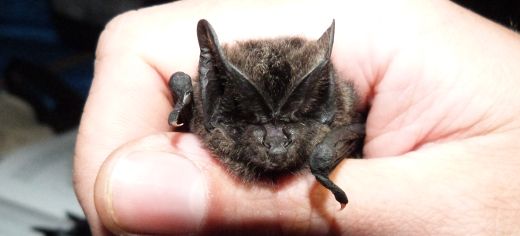
A bat species thought to be restricted to temperate forests has been found living thousands of miles from its known range in the sweltering heat of the southern Indian rainforest.
The discovery of the Eastern Barbastelle bat, a tiny, insect eating bat with distinctive silky black fur and large ears, in India’s southern Western Ghats was made by a team of researchers from the University of Leeds, the National Centre for Biological Sciences in India and the Nature Conservation Foundation of India, who are building a library of echolocation calls of southern Indian bats.
“It is a real shock to find the Eastern Barbastelle in the tropics—a bit like finding a red squirrel in the rainforest,” said lead researcher Claire Wordley of the University of Leeds’ Faculty of Biological Sciences.
“This underlines how much we still have to learn about the distribution and ecology of bats, not just in India but worldwide. About a quarter of bat species in the world are endangered. They are a diverse group of mammals performing important ecological roles, from insect control to pollination and seed dispersal, but for many species in tropical areas we lack even basic information on their abundance, their distribution and their habitat requirements.”
The Leeds’ team’s survey, published in the journal Acta Chiropterologica, identified and recorded the calls of 15 bat species in the Western Ghat mountains, one of the most biodiversity-rich locations on earth.
Building libraries of the echolocation calls bats use to navigate and hunt is important because the sounds provide a non-disruptive method of monitoring their populations. In relatively well studied areas, such as the UK, extensive call libraries allow researchers to closely follow different species by identifying the type and frequency of sounds.
Echolocation monitoring tends to yield more bat records than catching bats directly and, in the fast-moving, nocturnal world of echolocating bats, visual monitoring is usually impossible.
Wordley said: “The Eastern Barbastelle is not common in any of its range and is thought to be threatened by deforestation and war in many places. Finding it in parts of South India may be important to conservation of the species.”
The researchers also found two further species not known to live in this area, and recorded five species whose calls had never before been published. They found the echolocation calls of several species were different to those recorded from other parts of Asia, highlighting the need for more bat call libraries from tropical regions.
The project was funded by the Natural Environment Research Council (NERC). The Tamil Nadu Forest Department, the Tamil Nadu Electricity Board, Peria Karamalai Tea Company, Bombay Burmah Trading Corporation, Tata Coffee Ltd, Parry Agro Industries Ltd, Altaghat Estate and Thalanar Estate cooperated in the study.
Further information
Contact: Chris Bunting, Senior Press Officer, University of Leeds; phone +44 113 343 2049 or email c.j.bunting@leeds.ac.uk.
The full paper: Claire F. R. Wordley, Eleni K. Foui, Divya Mudappa, Mahesh Sankaran, and John D. Altringham ‘Acoustic identification of bats in the southern Western Ghats, India’ is published in journal Acta Chiropterologica, 16(1), 2014. (DOI: 10.3161/150811014X683408; URL: http://www.bioone.org/doi/abs/10.3161/150811014X683408.)